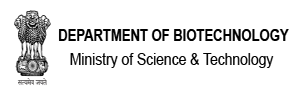
- Joy K Roy, PhD
- Scientist E
- Joining Date in NABI: August 9, 2010
- 0172-5221206
- joykroy[at]nabi.res.in; joykroy[at]gmail.com
Discipline and Specialization:
Agricultural Biotechnology- genomics information and marker technology for improvement and genetics and molecular basis of starch-based processing and nutrition quality through genome-wide association and linkage disequilibrium mapping approaches in wheat (Triticum aestivum).
Training/advance exposure in the area of work:
1. 454/Roche Genome Sequencer FLX-Technology, Application & Data, July 31, 2008, Minnesota Supercomputing Institute, University of Minnesota, St. Paul, USA
2. Barley CAP Association Genetics, Marker-Assisted Selection Workshop, June 16-18, 2008, University of Minnesota, St. Paul, Minnesota, USA
3.Genotyping of OPA1 SNP markers on Illumina GoldenGate Bead Technology
USDA-ARS Biosciences Research Lab, Fargo, USA
4.Statistical Training on SAS Proc Mixed by Micheal Casler, USDA-ARS, US Dairy Forage and Research Center, Madison (USA) at Dept of Agronomy and Plant Genetics, UMN
5. Statistical Trainee Summer Institute in Statistical Genetics, North Carolina State University, Raleigh, North Carolina (USA) (Module: Plant and Animal Association Mapping)
Contribution to the scientific advancement
1. An EMS-induced mutation population was developed in bread wheat (Triticum aestivum) for amylose (~3 to 76%) and resistant starch (~ 1 to 41%) variation (Mishra et al. 2016). The mutant population for amylose and resistant starch is first time developed for any plant species. These lines are resources for study of genetics and molecular basis for variation of amylose and resistant starch, improvement of wheat varieties for resistant starch, and development of resistant starch as product per se.
2. A set of candidate genes through transcriptome study (Singh et al. 2014) and phenolic compounds (Sharma et al. 2016) was identified for processing quality using two diverse Indian wheat varieties for good and poor chapatti.
Current area of research:
1. Development of high throughput DNA-based markers through next-gen sequencing:
A DNA-based marker is a gene or DNA sequence with a known location on a chromosome that can be used to identify individuals or a variation in the genomic loci that can affect a trait of interest. The marker can be a sequence surrounding a single base-pair change (single nucleotide polymorphism, SNP), or a short sequence of repeated nucleotides known as microsatellite or simple sequence repeat (SSR). Understanding complex genetic control of phenotypic variation is the major challenge facing by geneticists today. Recent advances in genomics technologies such as highly parallel sequencing for genome-wide assays of allelic variation has now made feasible for high resolution genetic characterization in crops. The use of high throughput genomic tools has tremendous potential to assist wheat geneticists and breeders to understand genetic basis of complex traits. At NABI, high throughput SNP markers are being developed through next-gen sequencings. These markers will be used to identify variations in genes or gene regions controlling processing and nutrition quality related traits in wheat germplasm. These resources will be available for breeders and geneticists for their wheat improvement programs.
2. Identification of gene regulators and networks of starch biosynthesis pathway in wheat:
Starch is the most abundant carbohydrate for storage reserve in seeds and the most important dietary source of energy representing upto 80% of the daily calorie intake. It is an insoluble polymer of glucose residues. It is important biomolecule not only for yield improvement in crops, but quality improvement of food and non-food products. The structure of starch effects physicochemical properties underpinning the different uses of starches. In most cases physicochemical properties are altered through chemical and enzyme modification, and physical treatment. The understanding of gene regulation and co-ordination of gene networks of starch biosynthesis pathway can lead to the production of many functional starches based upon prediction of starch structures through mutation and gene deletion. Recent advances in genomics technologies such as nextgen sequencing and chemical characterization such as mass spectrometer have made possible to decipher the detailed study of regulation of starch biosynthesis and to identify natural and induced mutations (TILLING) affecting starch function properties in wheat.
3. Molecular basis and genetics of high amylose starch and resistant starch in wheat grains:
Starch, glucose polymer, constitutes a major portion of cereal grains and presents in granular forms known as starch granules. It is composed of two distinct components- amylose and amylopectin - constituting about 25% and 75% of total starch content, respectively. Their ratio greatly affects processing, cooking, organoleptic quality, and nutrition quality of starchy grain based products. Further, amylose component of starch is considered as healthy starch or resistant starch. Variation in amylose content (20-25%) and resistant starch (< 2.0%) is narrow in wheat. Therefore, it is of great interest to produce lines showing variation in amylose content and resistant starch. So far there is no report of wide dynamic range of amylose content in the same genetic background in wheat or any other plant species. In this study, a chemical agent that induces random point mutation in genome was used to generate a M4 mutation population in background of an Indian wheat variety, ‘C 306’ that is traditionally known for good chapatti variety and a gold standard for good chapatti variety development. Several mutants lines (M4 generation) have been identified showing variation in amylose content (~3 to 76%) and in resistant starch (~1 to 41%). The high amylose (>40%) and high resistant starch (>10%) lines are being used for their molecular basis and genetics through transcriptome sequencing and developing F2 populations. These lines will be evaluated for their effect on quality of end-use food products.
Publications (best five):
1. Rahim M. S., Sharma H., Parveen A., Roy JK* (2018). Trait mapping approaches through association analysis in plants. In: Advances in Biochemical Engineering/Biotechnology. Springer, Berlin, Heidelberg. Doi: 10.1007/10_2017_50. *corresponding author
2. Sharma M., Sandhir R.*, Singh A., Kumar P., Mishra A., Jachak S., Singh S.P., Singh J., Roy J* (2016). Comparative analysis of phenolic compound characterization and their biosynthesis genes between two diverse bread wheat (Triticum aestivum) varieties differing for chapatti (unleavened flat bread) quality. Frontiers in Plant Science (doi: 10.3389/fpls.2016.01870). *corresponding author
3. Mishra A, Singh A, Sharma M, Kumar P, Roy J* (2016) Development of EMS-induced mutation population for amylose and resistant starch variation in bread wheat (Triticum aestivum) and identification of candidate genes responsible for amylose variation. BMC Plant Biology 16: 217 (DOI: 10.1186/s12870-016-0896-z) *corresponding author
4. Singh A, Kumar P, Sharma M, Tuli R, Dhaliwal HS, Chaudhury A, Pal D, Roy J* (2015). Understanding of expression patterns of genes involved in starch biosynthesis during seed development in bread wheat (Triticum aestivum). Molecular Breeding 35: 184 [doi: 10.1007/s11032-015-0371-9]. *corresponding author
5. Singh A, Mantri S, Sharma M, Chaudhury A, Tuli R, Roy J* (2014) Genome-wide transcriptome study in wheat identified candidate genes related to processing quality, majority of them showing interaction (quality x development) and having temporal and spatial distributions. BMC Genomics 15: 29. [doi: 10.1186/1471-2164-15-29]. *corresponding author
Awards and Fellowships
1. Recipient National Merit Scholarship (1992-1994) of Government of India for MSc study
2. Qualified Graduate Aptitude Test in Engineering (GATE) - 1996, organised by the Department of Education, Ministry of Human Resource Development, Government of India




